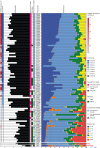Interpretation of somatic POLE mutations in endometrial carcinoma
- PMID: 31829442
- PMCID: PMC7065171
- DOI: 10.1002/path.5372
Interpretation of somatic POLE mutations in endometrial carcinoma
Abstract
Pathogenic somatic missense mutations within the DNA polymerase epsilon (POLE) exonuclease domain define the important subtype of ultramutated tumours ('POLE-ultramutated') within the novel molecular classification of endometrial carcinoma (EC). However, clinical implementation of this classifier requires systematic evaluation of the pathogenicity of POLE mutations. To address this, we examined base changes, tumour mutational burden (TMB), DNA microsatellite instability (MSI) status, POLE variant frequency, and the results from six in silico tools on 82 ECs with whole-exome sequencing from The Cancer Genome Atlas (TCGA). Of these, 41 had one of five known pathogenic POLE exonuclease domain mutations (EDM) and showed characteristic genomic alterations: C>A substitution > 20%, T>G substitutions > 4%, C>G substitutions < 0.6%, indels < 5%, TMB > 100 mut/Mb. A scoring system to assess these alterations (POLE-score) was developed; based on their scores, 7/18 (39%) additional tumours with EDM were classified as POLE-ultramutated ECs, and the six POLE mutations present in these tumours were considered pathogenic. Only 1/23 (4%) tumours with non-EDM showed these genomic alterations, indicating that a large majority of mutations outside the exonuclease domain are not pathogenic. The infrequent combination of MSI-H with POLE EDM led us to investigate the clinical significance of this association. Tumours with pathogenic POLE EDM co-existent with MSI-H showed genomic alterations characteristic of POLE-ultramutated ECs. In a pooled analysis of 3361 ECs, 13 ECs with DNA mismatch repair deficiency (MMRd)/MSI-H and a pathogenic POLE EDM had a 5-year recurrence-free survival (RFS) of 92.3%, comparable to previously reported POLE-ultramutated ECs. Additionally, 14 cases with non-pathogenic POLE EDM and MMRd/MSI-H had a 5-year RFS of 76.2%, similar to MMRd/MSI-H, POLE wild-type ECs, suggesting that these should be categorised as MMRd, rather than POLE-ultramutated ECs for prognostication. This work provides guidance on classification of ECs with POLE mutations, facilitating implementation of POLE testing in routine clinical care. © 2019 The Authors. The Journal of Pathology published by John Wiley & Sons Ltd on behalf of Pathological Society of Great Britain and Ireland.
Keywords: POLE; endometrial cancer; molecular classification.
© 2019 The Authors. The Journal of Pathology published by John Wiley & Sons Ltd on behalf of Pathological Society of Great Britain and Ireland.
Figures



References
-
- Howitt BE, Shukla SA, Sholl LM, et al Association of polymerase e‐mutated and microsatellite‐instable endometrial cancers with neoantigen load, number of tumor‐infiltrating lymphocytes, and expression of PD‐1 and PD‐L1. JAMA Oncol 2015; 1: 1319–1323. - PubMed
-
- Stelloo E, Nout RA, Osse EM, et al Improved risk assessment by integrating molecular and clinicopathological factors in early‐stage endometrial cancer – combined analysis of the PORTEC cohorts. Clin Cancer Res 2016; 22: 4215–4224. - PubMed
Publication types
MeSH terms
Substances
Grants and funding
LinkOut - more resources
Full Text Sources
Other Literature Sources
Medical
Miscellaneous

